
The first USS Dixie was a United States Navy auxiliary cruiser and later a destroyer tender. The Dixie was the first ship of the United States Navy to have this name.

The Royal Fleet Auxiliary (RFA) is a naval auxiliary fleet owned by the UK's Ministry of Defence. It is a component of His Majesty's Naval Service and provides logistical and operational support to the Royal Navy and Royal Marines. The RFA ensures the Royal Navy is supplied and supported by providing fuel and stores through replenishment at sea, transporting Royal Marines and British Army personnel, providing medical care and transporting equipment and essentials around the world. In addition the RFA acts independently providing humanitarian aid, counter piracy and counter narcotic patrols together with assisting the Royal Navy in preventing conflict and securing international trade. They are a uniformed civilian branch of the Royal Navy staffed by British merchant sailors. The RFA is one of five RN fighting arms.
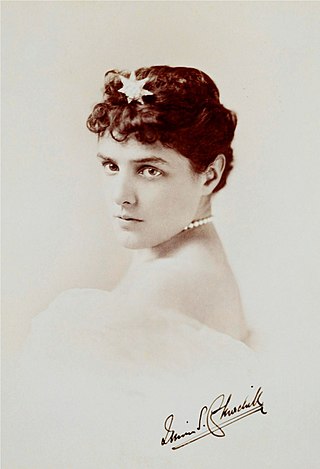
Jeanette Spencer-Churchill, known as Lady Randolph Spencer-Churchill, was an American-born British socialite, the wife of Lord Randolph Churchill, and the mother of British prime minister Winston Churchill.

RFA Diligence was a forward repair ship of the Royal Fleet Auxiliary. Launched in 1981 as a support ship for North Sea oil rigs, she was chartered by the British government to support naval activities during the 1982 Falklands War and was later bought outright as a fleet maintenance vessel. She gave assistance to the damaged USS Tripoli and Princeton in the 1991 Gulf War, and to Sri Lanka after the 2005 tsunami. She typically had deployments of 5-8 years in support of the Trafalgar-class submarine on duty east of Suez, with a secondary role as a mothership for British and US minesweepers in the Persian Gulf. Until 2016 Diligence was set to go out of service in 2020. However in August 2016, the UK Ministry of Defence placed an advert for the sale of RFA Diligence. As of 2016 the option for the delivery of future operational maintenance and repair capability for the RFA remained under consideration. However, the 2021 British defence white paper made no specific mention of the need for this capability. In April 2023, it was revealed that the ship was to be scrapped after no suitable buyers materialised, & she was moved out of 3 Basin across to Fareham Trots to await her final journey to the scrapyard.

RFA Argus is a ship of the Royal Fleet Auxiliary operated by the Ministry of Defence under the Blue Ensign. Italian-built, Argus was formerly the container ship MVContender Bezant. The ship was requisitioned in 1982 for service in the Falklands War and purchased outright in 1984 for a four-year conversion to an Aviation Training Ship, replacing RFA Engadine. In 1991, during the Gulf War, she was fitted with an extensive and fully functional hospital to assume the additional role of Primary Casualty Receiving Ship. In 2009, the PCRS role became the ship's primary function. Argus is due to remain in service beyond 2030. In July 2022 it was reported that the future Littoral Strike Role would be assumed by Argus after a refit to convert her to this role. As of October 2023, Argus had started her deployment to serve as part of Littoral Response Group (South) based out of the UK Joint Logistics Support Base in Oman.

The British Pacific Fleet (BPF) was a Royal Navy formation that saw action against Japan during the Second World War. It was formed from aircraft carriers, other surface warships, submarines and supply vessels of the RN and British Commonwealth navies in November 1944.
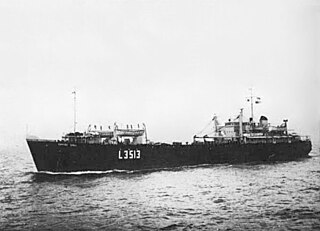
RFA Empire Gull (L3513) was a landing ship, tank of the Royal Fleet Auxiliary. She was familiarly known as the "Black Pig" and was one of the last serving British LSTs. She was built as LST 3523, one of the Empire Ships, and later commissioned as HMS Trouncer. During the Suez Crisis she was pressed into Government service as SS Empire Gull. In 1970 she was transferred to the Royal Fleet Auxiliary as RFA Empire Gull, serving for ten years before being scrapped.
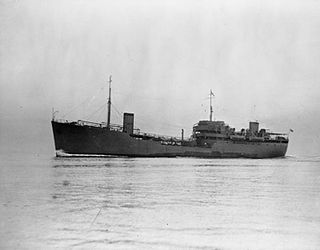
RFA Green Ranger was a Ranger-class fleet support tanker of the Royal Fleet Auxiliary.

RFA Aldersdale (X34) was a Dale-class fleet tanker of the Royal Fleet Auxiliary.
There have been five British Royal Fleet Auxiliary hospital ships named RFA Maine.
RFA Abadol was a British cargo liner, converted several times to end as a tanker in the Royal Fleet Auxiliary. She was previously known as SS Montezuma from her launch in 1899 until 1915. From February 1917, she was named RFA Oakleaf. A few months later she was lost without casualties to a German torpedo attack.
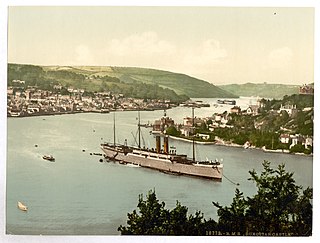
RMS Dunottar Castle was a Royal Mail Ship that went into service with the Castle Line in 1890 on the passenger and mail service between Britain and South Africa. In 1913 the ship was sold to the Royal Mail Steam Packet Company as the Caribbean. After the outbreak of the First World War she served as HMS Caribbean, first as a troop ship and then as an armed merchant cruiser, until she sank in a storm off the Scottish coast on 27 September 1915.

The Dale class were a class of replenishment oilers taken up for service with the Royal Fleet Auxiliary, supporting the Royal Navy during the inter-war period. They went on to see action during the Second World War and supported British and allied fleet units in Cold War conflicts such as the Korean War.
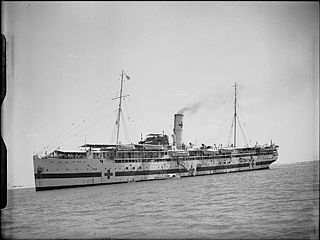
Royal Fleet Auxiliary ship Maine was a hospital ship of the British Royal Fleet Auxiliary, that served during the First World War and the Second World War.

SS Polar Chief was a merchant steamship that was built in England in 1897 and scrapped in Scotland in 1952. In her 55-year career she had previously been called Montcalm, RFA Crenella, Crenella, Rey Alfonso, Anglo-Norse and Empire Chief. Early in the First World War she spent eight months pretending to be the battleship HMS Audacious.
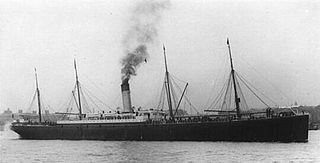
SS Armenian was an 1895-built British cargo liner built for the Leyland Line, but managed by the White Star Line from 20 March 1903. She was employed on the cargo service between Liverpool and New York City, with the passenger service between the two ports having been previously withdrawn. In 1910 she was repainted in the Leyland livery.

United States Navy Auxiliary ship Sterling was an iron, schooner-rigged collier in service with the United States Navy from 1898 to 1919. Originally purchased to transport coal for United States Navy ships during the Spanish–American War, she served in that role until sold in 1919. While serving as the Chilean flagged steamer, Llai Llai, she was rammed by a Chilean warship on 11 March 1920 and sank near Iquique, Chile.

Jennie Goodell Blow was a prominent American-born socialite. Blow resided in a number of different locations during her life. Hailing from a prominent family, married to a wealthy man, and reputed for her beauty, Blow established herself as a leading society figure in several different cities. While residing in the United Kingdom, she was a leader in the successful effort to convert the Maine into a hospital ship during the Boer War. The idea for this effort had been Blow's. She worked with Lady Randolph Churchill and Fanny Ronalds to lead this effort and was recognized for it by Queen Victoria and later Edward VII.
















